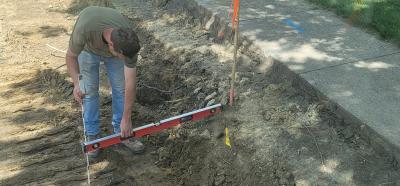The construction industry generates an estimated 325-million tons (292.5 million t) of construction and demolition (C&D) waste each year, including 189-million tons (170.1 million t) from road and bridge projects and 136-million tons (122.4 million t) from building activity. This waste from highway and building construction actually far exceeds total municipal solid waste (garbage), which is approximately 215 million tons (193.5 million t) a year.
That’s a heap of trouble.
Most C&D waste, which isn’t recycled, is usually indiscriminately dumped into landfills, with contractors paying fairly hefty “tipping” fees to the haulers who carry it from job sites to fills.
As construction of highways and homes boom, some states are running out of conveniently located landfills. States also are concerned about the environmental effects of some materials being dumped, such as gypsum, the main component in wallboard, which generates hydrogen sulfide gas as it decomposes in the fill.
Where will construction debris go in the future?
Dave Ryan, a spokesman for EPA, said his agency isn’t concerned about current landfill capacity.
“At the national level, capacity does not appear to be a problem, though regional dislocations sometimes occur,” he told Construction Equipment Guide (CEG). He said there are 1,858 C&D landfills in the United States.
But observers say trouble could be coming under the continuing onslaught of everything from wood beams to metal highway rebar.
States are now taking a hard look at their entire disposal systems with an eye toward alleviating potential problems and increasing efficiency. They are encouraging, or even mandating, more recycling instead of dumping, and more “source separation” of materials at contractor work sites, hauling them in separate bins to recycling plants. Whatever steps they take, of course, would impact contractors, who worry about the possibility of increased costs.
Ban Materials From Landfills?
One way to reduce landfill use is to ban certain C&D debris from being dumped, changing the ground rules significantly because waste disposal sites have been an open market for contractors, who can put almost everything in a solid waste landfill.
In what is being called a “grand experiment,” Massachusetts plans to ban certain types of materials from its landfills this fall. This would be the first direct ban in the United States of these materials from disposal in landfills, though other states are encouraging contractors to pull as much out of the waste stream as possible.
The banned materials would be concrete, asphalt, brick, wood, old corrugated cardboard, and metals.
“Our basic requirement is that those materials must not be disposed of at solid waste facilities, which by implication means we want to see them recycled, or reused in some fashion,” James Doucett, deputy director for business and compliance of the Massachusetts Department of Environmental Protection (DEP), told CEG.
“We want to move ourselves toward our goal of diverting as much waste from the solid waste stream, and from disposal, as possible,” Doucett said. “We have specific goals for diverting 80 percent of our waste, and construction and demolition debris is a significant portion of this waste stream. We also don’t have enough [landfill] capacity to manage all our solid waste. The ban would reduce the space taken up with construction materials.”
(Most landfills in Massachusetts are privately owned commercial operations.)
The Massachusetts DEP completed public-comment hearings on July 1 on proposed amendments to its solid waste regulations, which would ban the six types of waste. It will receive further public comment throughout July and plans to issue final regulations in the fall, also announcing their phase-in period. (The new regulations may be revised somewhat from the initial proposal because of input from the public.)
What Will Contractors Do?
When Massachusetts, and possibly other states later, ban most C&D debris from landfills, contractors will have to seriously consider sending the debris to a recycling facility that would pull out useful items and process them.
“In many cases, processors are establishing pricing structures to attract this material, particularly if it is source-separated at the work site,” Doucett said. “If contractors separated wood into its own bin, for instance, some processors would offer an actual cost saving for that material [versus putting it into a landfill]. Landfill disposal costs are upwards from $70 to $100 a ton. Processors are generally able to charge a lower tipping fee than that because they can reuse the material and offset the tipping fee at the front end.
“We have completed several pilot projects where contractors on job sites have performed some separations and have achieved pretty significant cost-savings vs. landfills.”
Contractors still might consider hauling debris to landfills in neighboring states. This could be feasible at locations close to another state. Usually, however, tying up trucks for longer hauls would be too costly.
“Grand Experiment”
Massachusetts feels it’s in a good position to try the ban. It has the right recycling infrastructure, with 10 facilities, which process C&D materials.
“It is a grand experiment that I expect to work,” said William Turley, executive director of the Construction Materials Recycling Association (CMRA) in Lisle, IL. “It is going to be interesting because they [Massachusetts] have the infrastructure in place, the facilities to handle it [C&D waste], and the markets to take the material once it’s processed. We are considering it [the proposed ban] a boon, though we want to see if it will work out economically in the long run. They are legislating, rather than letting the market take care of it, but I think in this case they will be able to pull it off, if only because tipping fees for dumping into a landfill are so high there.”
Turley observed, however: “All the states surrounding Massachusetts are looking at the ban to see if it will work. They’re concerned that the stuff will float over the border to their property.”
Banning construction debris isn’t always a monumental change. Contractors already usually recycle most asphalt, concrete, brick and metal. Only “residuals” – leftovers from these recycling operations – are ground up for use in grading and shaping landfills.
Banning wood, however, would be a considerable change, since most wood goes directly to the fills.
Some contractors voice doubts about the ban. The National Association of Demolition Contractors (NADC) in Doylestown, PA, for instance, wants the option of using landfills for whatever it can’t economically recycle. It says contractors will simply use landfills in other states. (See C&D Convoy to the Border, page 136.)
Outlook for Future
Turley doesn’t expect other states to quickly follow Massachusetts’ lead.
“They are all watching what Massachusetts does, but I don’t expect anything like it [the ban] to happen anywhere in the country for a while,” he said. “However, I do expect more recycling to take place because of other regulatory action. I wouldn’t be surprised to see gypsum banned from landfills in the future, with all this implies for the contractor on the site.”
Turley said environmental concerns from such organizations as LEED (Leadership in Energy & Environmental Design), part of the U.S. Green Building Council “are driving pressures, which will bring more recycling, especially at construction sites, in the future.”
He said this would “perhaps mean greater expense for contractors,” explaining: “The amount of money which contractors spend to get rid of waste is far under 1 percent of the total cost of the project. It’s now a relatively small expense. Where you get the expense is if you have to source-separate the material instead of dumping it into one big box. Contractors may have to source-separate in the future, though this isn’t required at present. It’s still pretty much up to the contractor at this stage. I would be surprised if it were ever a state law. However, I wouldn’t be surprised if states make it more economically feasible to recycle. Right now, contractors can do whatever they want, whatever is cheapest, as long as it’s legal disposal.”
(Further information is available on cdrecycling.org).
Today's top stories















